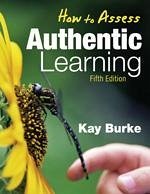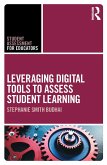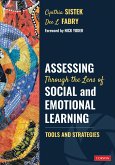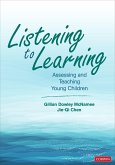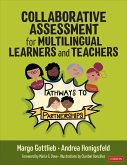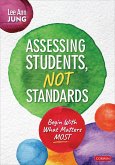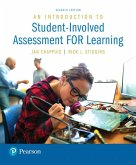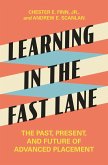Kathleen B. Burke
How to Assess Authentic Learning
Kathleen B. Burke
How to Assess Authentic Learning
- Broschiertes Buch
- Merkliste
- Auf die Merkliste
- Bewerten Bewerten
- Teilen
- Produkt teilen
- Produkterinnerung
- Produkterinnerung
This updated edition helps primary and secondary teachers build observation checklists, develop unit plans, and design performance tasks and rubrics that address mandated academic standards.
Andere Kunden interessierten sich auch für
![Leveraging Digital Tools to Assess Student Learning Leveraging Digital Tools to Assess Student Learning]() Stephanie Smith BudhaiLeveraging Digital Tools to Assess Student Learning34,99 €
Stephanie Smith BudhaiLeveraging Digital Tools to Assess Student Learning34,99 €![Assessing Through the Lens of Social and Emotional Learning Assessing Through the Lens of Social and Emotional Learning]() Cynthia SistekAssessing Through the Lens of Social and Emotional Learning39,99 €
Cynthia SistekAssessing Through the Lens of Social and Emotional Learning39,99 €![Listening to Learning Listening to Learning]() Gillian Dowley McNameeListening to Learning31,99 €
Gillian Dowley McNameeListening to Learning31,99 €![Collaborative Assessment for Multilingual Learners and Teachers Collaborative Assessment for Multilingual Learners and Teachers]() Margo GottliebCollaborative Assessment for Multilingual Learners and Teachers33,99 €
Margo GottliebCollaborative Assessment for Multilingual Learners and Teachers33,99 €![Assessing Students, Not Standards Assessing Students, Not Standards]() Lee Ann JungAssessing Students, Not Standards39,99 €
Lee Ann JungAssessing Students, Not Standards39,99 €![An Introduction to Student-Involved Assessment for Learning An Introduction to Student-Involved Assessment for Learning]() Jan ChappuisAn Introduction to Student-Involved Assessment for Learning124,99 €
Jan ChappuisAn Introduction to Student-Involved Assessment for Learning124,99 €![Learning in the Fast Lane Learning in the Fast Lane]() Finn, Chester E., Jr.Learning in the Fast Lane21,99 €
Finn, Chester E., Jr.Learning in the Fast Lane21,99 €-
-
-
This updated edition helps primary and secondary teachers build observation checklists, develop unit plans, and design performance tasks and rubrics that address mandated academic standards.
Produktdetails
- Produktdetails
- Verlag: SAGE Publications Inc
- Artikelnr. des Verlages: B62780P
- 5 Revised edition
- Seitenzahl: 232
- Erscheinungstermin: 7. Oktober 2009
- Englisch
- Abmessung: 279mm x 217mm x 17mm
- Gewicht: 650g
- ISBN-13: 9781412962797
- ISBN-10: 141296279X
- Artikelnr.: 26220147
- Herstellerkennzeichnung
- Libri GmbH
- Europaallee 1
- 36244 Bad Hersfeld
- gpsr@libri.de
- Verlag: SAGE Publications Inc
- Artikelnr. des Verlages: B62780P
- 5 Revised edition
- Seitenzahl: 232
- Erscheinungstermin: 7. Oktober 2009
- Englisch
- Abmessung: 279mm x 217mm x 17mm
- Gewicht: 650g
- ISBN-13: 9781412962797
- ISBN-10: 141296279X
- Artikelnr.: 26220147
- Herstellerkennzeichnung
- Libri GmbH
- Europaallee 1
- 36244 Bad Hersfeld
- gpsr@libri.de
Kay Burke has served as an award-winning classroom teacher and a school administrator, university instructor, and international professional developer. She works with Kay Burke & Associates, LLC, to provide workshops for teachers and administrators in standards-based learning, performance assessment, classroom management, mentoring, and portfolio development. For the past 18 years, Burke has presented at state and national conferences such as ASCD, NSDC, NAESP, NASSP, NMSA, and IRA as well as international conferences in Canada and Australia. She is the author of 10 professional development books and coauthor of a college textbook on assessment. Corwin Press published Burke¿s best-selling From Standards to Rubrics in Six Steps: Tools for Assessing Student Learning, K-8 (2006), a 2007 finalist for the Distinguished Achievement Award for Excellence in Educational Publishing presented by the Association of Educational Publishers. Other books published by Corwin Press include How to Assess Authentic Learning, Fourth Edition (2005) and What to Do With the Kid Who: Developing Cooperation, Self-Discipline and Responsibility in the Classroom (Third Edition).
Acknowledgments
About the Author
Introduction
Standardized Tests and Classroom Assessments
Assessment Literacy
Accountability
Grading
Traditional Cognitive Science
Assessment and Evaluation
Definitions of Performance Assessment
Portfolios
Balanced Assessment
And Now...the Tools!
1. Student Learning Standards
What Are Learning Standards and Benchmarks?
What Is the Standards Movement?
How Did the Standards Movement Begin?
What Are Preformance Standards?
Why Do We Need Standards?
How Can We Use Standards?
Final Thoughts
2. Differentiated Learning
What Is Differentiated Learning?
What Are the Multiple Intelligences?
Why Should We Use Differentiation?
How Should We Use the Multiple intelligences?
Final Thoughts
3. Student Portfolios
What is a Portfolio?
Why Should We Use Portfolios?
How Can We Implement Portfolios?
Final Thoughts
4. Performance Tasks and Rubrics
What Are Performance Tasks?
Why Should We Use Performance Tasks?
How Should We Create Performance Tasks?
How Should We Assess Performance Tasks?
Final Thoughts
5. Checklists and Rubrics
What Are Checklists?
Why Should We Use Checklists?
How Should We Use Checklists?
What Are Rubrics?
How Should We Use Rubrics?
How Can Rubrics Be Used?
What is the Checklist-Rubrics Connection?
How Do We Create Assessments?
Final Thoughts
6. Metacognition
What Is Metacognitive Reflection?
Why Should We Use Megacognitive Reflection?
How Should We Use Megacognitive Reflection?
What Are Learning Logs and Journals?
Why Should We Use Learning Logs and Journals?
How Should We Use Learning Logs and Journals?
How Should We Assess Learning Logs and Journals??
Finals Thoughts
7. Graphic Organizers
What Are Graphic Organizers?
Why Should We Use Graphic Organizers?
How Should Graphic Organizers Be Used For Assessment?
Final Thoughts
8. Teacher-Made Tests
What Are Teacher-Made Tests?
Why Do We Need Teacher-Made Tests?
How Can We Design Better Teacher-Made Tests?
Final Thoughts
9. Interviews and Conferences
What Are Interviews and Conferences?
Why Should We Use Interviews and Conferences?
How Should We Assess Interviews and Conferences?
Final Thoughts
Conclusion
Resources: Performance Task Units
Resource A: Investigating Rocks, Minerals, and Soils in Third-Grade Science
Resource B: A Middle School Economics Performance Task
Resource C: Using Algebra to Plan a Garden Party
Resource D: Foreign Language Performance Task for Middle and High School
Resource E: Thinking About Themes Through texts and Tasks in Literature,
Grades 9-12
References
Index
About the Author
Introduction
Standardized Tests and Classroom Assessments
Assessment Literacy
Accountability
Grading
Traditional Cognitive Science
Assessment and Evaluation
Definitions of Performance Assessment
Portfolios
Balanced Assessment
And Now...the Tools!
1. Student Learning Standards
What Are Learning Standards and Benchmarks?
What Is the Standards Movement?
How Did the Standards Movement Begin?
What Are Preformance Standards?
Why Do We Need Standards?
How Can We Use Standards?
Final Thoughts
2. Differentiated Learning
What Is Differentiated Learning?
What Are the Multiple Intelligences?
Why Should We Use Differentiation?
How Should We Use the Multiple intelligences?
Final Thoughts
3. Student Portfolios
What is a Portfolio?
Why Should We Use Portfolios?
How Can We Implement Portfolios?
Final Thoughts
4. Performance Tasks and Rubrics
What Are Performance Tasks?
Why Should We Use Performance Tasks?
How Should We Create Performance Tasks?
How Should We Assess Performance Tasks?
Final Thoughts
5. Checklists and Rubrics
What Are Checklists?
Why Should We Use Checklists?
How Should We Use Checklists?
What Are Rubrics?
How Should We Use Rubrics?
How Can Rubrics Be Used?
What is the Checklist-Rubrics Connection?
How Do We Create Assessments?
Final Thoughts
6. Metacognition
What Is Metacognitive Reflection?
Why Should We Use Megacognitive Reflection?
How Should We Use Megacognitive Reflection?
What Are Learning Logs and Journals?
Why Should We Use Learning Logs and Journals?
How Should We Use Learning Logs and Journals?
How Should We Assess Learning Logs and Journals??
Finals Thoughts
7. Graphic Organizers
What Are Graphic Organizers?
Why Should We Use Graphic Organizers?
How Should Graphic Organizers Be Used For Assessment?
Final Thoughts
8. Teacher-Made Tests
What Are Teacher-Made Tests?
Why Do We Need Teacher-Made Tests?
How Can We Design Better Teacher-Made Tests?
Final Thoughts
9. Interviews and Conferences
What Are Interviews and Conferences?
Why Should We Use Interviews and Conferences?
How Should We Assess Interviews and Conferences?
Final Thoughts
Conclusion
Resources: Performance Task Units
Resource A: Investigating Rocks, Minerals, and Soils in Third-Grade Science
Resource B: A Middle School Economics Performance Task
Resource C: Using Algebra to Plan a Garden Party
Resource D: Foreign Language Performance Task for Middle and High School
Resource E: Thinking About Themes Through texts and Tasks in Literature,
Grades 9-12
References
Index
Acknowledgments
About the Author
Introduction
Standardized Tests and Classroom Assessments
Assessment Literacy
Accountability
Grading
Traditional Cognitive Science
Assessment and Evaluation
Definitions of Performance Assessment
Portfolios
Balanced Assessment
And Now...the Tools!
1. Student Learning Standards
What Are Learning Standards and Benchmarks?
What Is the Standards Movement?
How Did the Standards Movement Begin?
What Are Preformance Standards?
Why Do We Need Standards?
How Can We Use Standards?
Final Thoughts
2. Differentiated Learning
What Is Differentiated Learning?
What Are the Multiple Intelligences?
Why Should We Use Differentiation?
How Should We Use the Multiple intelligences?
Final Thoughts
3. Student Portfolios
What is a Portfolio?
Why Should We Use Portfolios?
How Can We Implement Portfolios?
Final Thoughts
4. Performance Tasks and Rubrics
What Are Performance Tasks?
Why Should We Use Performance Tasks?
How Should We Create Performance Tasks?
How Should We Assess Performance Tasks?
Final Thoughts
5. Checklists and Rubrics
What Are Checklists?
Why Should We Use Checklists?
How Should We Use Checklists?
What Are Rubrics?
How Should We Use Rubrics?
How Can Rubrics Be Used?
What is the Checklist-Rubrics Connection?
How Do We Create Assessments?
Final Thoughts
6. Metacognition
What Is Metacognitive Reflection?
Why Should We Use Megacognitive Reflection?
How Should We Use Megacognitive Reflection?
What Are Learning Logs and Journals?
Why Should We Use Learning Logs and Journals?
How Should We Use Learning Logs and Journals?
How Should We Assess Learning Logs and Journals??
Finals Thoughts
7. Graphic Organizers
What Are Graphic Organizers?
Why Should We Use Graphic Organizers?
How Should Graphic Organizers Be Used For Assessment?
Final Thoughts
8. Teacher-Made Tests
What Are Teacher-Made Tests?
Why Do We Need Teacher-Made Tests?
How Can We Design Better Teacher-Made Tests?
Final Thoughts
9. Interviews and Conferences
What Are Interviews and Conferences?
Why Should We Use Interviews and Conferences?
How Should We Assess Interviews and Conferences?
Final Thoughts
Conclusion
Resources: Performance Task Units
Resource A: Investigating Rocks, Minerals, and Soils in Third-Grade Science
Resource B: A Middle School Economics Performance Task
Resource C: Using Algebra to Plan a Garden Party
Resource D: Foreign Language Performance Task for Middle and High School
Resource E: Thinking About Themes Through texts and Tasks in Literature,
Grades 9-12
References
Index
About the Author
Introduction
Standardized Tests and Classroom Assessments
Assessment Literacy
Accountability
Grading
Traditional Cognitive Science
Assessment and Evaluation
Definitions of Performance Assessment
Portfolios
Balanced Assessment
And Now...the Tools!
1. Student Learning Standards
What Are Learning Standards and Benchmarks?
What Is the Standards Movement?
How Did the Standards Movement Begin?
What Are Preformance Standards?
Why Do We Need Standards?
How Can We Use Standards?
Final Thoughts
2. Differentiated Learning
What Is Differentiated Learning?
What Are the Multiple Intelligences?
Why Should We Use Differentiation?
How Should We Use the Multiple intelligences?
Final Thoughts
3. Student Portfolios
What is a Portfolio?
Why Should We Use Portfolios?
How Can We Implement Portfolios?
Final Thoughts
4. Performance Tasks and Rubrics
What Are Performance Tasks?
Why Should We Use Performance Tasks?
How Should We Create Performance Tasks?
How Should We Assess Performance Tasks?
Final Thoughts
5. Checklists and Rubrics
What Are Checklists?
Why Should We Use Checklists?
How Should We Use Checklists?
What Are Rubrics?
How Should We Use Rubrics?
How Can Rubrics Be Used?
What is the Checklist-Rubrics Connection?
How Do We Create Assessments?
Final Thoughts
6. Metacognition
What Is Metacognitive Reflection?
Why Should We Use Megacognitive Reflection?
How Should We Use Megacognitive Reflection?
What Are Learning Logs and Journals?
Why Should We Use Learning Logs and Journals?
How Should We Use Learning Logs and Journals?
How Should We Assess Learning Logs and Journals??
Finals Thoughts
7. Graphic Organizers
What Are Graphic Organizers?
Why Should We Use Graphic Organizers?
How Should Graphic Organizers Be Used For Assessment?
Final Thoughts
8. Teacher-Made Tests
What Are Teacher-Made Tests?
Why Do We Need Teacher-Made Tests?
How Can We Design Better Teacher-Made Tests?
Final Thoughts
9. Interviews and Conferences
What Are Interviews and Conferences?
Why Should We Use Interviews and Conferences?
How Should We Assess Interviews and Conferences?
Final Thoughts
Conclusion
Resources: Performance Task Units
Resource A: Investigating Rocks, Minerals, and Soils in Third-Grade Science
Resource B: A Middle School Economics Performance Task
Resource C: Using Algebra to Plan a Garden Party
Resource D: Foreign Language Performance Task for Middle and High School
Resource E: Thinking About Themes Through texts and Tasks in Literature,
Grades 9-12
References
Index

